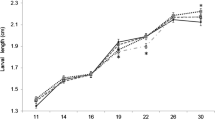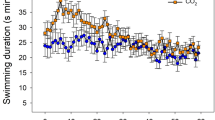Abstract
CO2-enriched seawater was far more toxic to eggs and larvae of a marine fish, silver seabream, Pagrus major, than HCl-acidified seawater when tested at the same seawater pH. Data on the effects of acidified seawater can therefore not be used to estimate the toxicity of CO2, as has been done in earlier studies. Ontogenetic changes in CO2 tolerance of two marine bony fishes (Pag. major and Japanese sillago, Sillago japonica) showed a similar, characteristic pattern: the cleavage and juvenile stages were most susceptible, whereas the preflexion and flexion stages were much more tolerant to CO2. Adult Japanese amberjack, Seriola quinqueradiata, and bastard halibut, Paralichthys olivaceus, died within 8 and 48 h, respectively, during exposure to seawater equilibrated with 5% CO2. Only 20% of a cartilaginous fish, starspotted smooth-hound, Mustelus manazo, died at 7% CO2 within 72 h. Arterial pH initially decreased but completely recovered within 1-24 h for Ser. quinqueradiata and Par. olivaceus at 1 and 3% CO2, but the recovery was slower and complete only at 1% for M. manazo. During exposure to 5% CO2, Par. olivaceus died after arterial pH had been completely restored. Exposure to 5% CO2 rapidly depressed the cardiac output of Ser. quinqueradiata, while 1% CO2 had no effect. Both levels of ambient CO2 had no effect on blood O2 levels. We tentatively conclude that cardiac failure is important in the mechanisms by which CO2 kills fish. High CO2 levels near injection points during CO2 ocean sequestration are likely to have acute deleterious effects on both larvae and adults of marine fishes.
Similar content being viewed by others
References
Auerbach, D. I., J. A. Caufield, E. E. Adams and H. J. Herzog (1997): Impacts of ocean CO2 disposal on marine life: I. A toxicological assessment integrating constant-concentration laboratory assay data with variable-concentration field exposure. Environ. Model. Assess., 2, 333–343.
Bernier, N. J. and D. J. Randall (1998): Carbon dioxide anaes-thesia in rainbow trout: effects of hypercapnic level and stress on induction and recovery from anaesthetic treatment. J. Fish Biol., 52, 621–637.
Burleson, M. L. and N. J. Smatresk (2000): Branchial chemoreceptors mediate ventilatory responses to hypercap-nic acidosis in channel catfish. Comp. Biochem. Physiol., 125A, 403–414.
Claiborne, J. B. and D. H. Evans (1992): Acid-base balance and ion transfers in the spiny dogfish (Squalus acanthias) during hypercapnia: A role for ammonia excretion. J. Exp. Zool., 261, 9–17.
Claiborne, J. B. and N. Heisler (1986): Acid-base regulation and ion transfers in the carp (Cyprinus carpio): pH com-pensation during graded long-and short-term environmental hypercapnia, and the effect of bicarbonate infusion. J. Exp. Biol., 126, 41–61.
Claiborne, J. B., S. L. Edwards and A. I. Morrison-Shetlar (2002): Acid-base regulation in fishes: cellular and molecu-lar mechanisms. J. Exp. Zool., 293, 302–319.
Crocker, C. E., A. P. Farrell, A. K. Gamperl and J. J. Cech, Jr. (2000): Cardiorespiratory responses of white sturgeon to environmental hypercapnia. Am. J. Physiol., 279, R617–R628.
Cross, C. E., B. S. Packer, J. M. Linta, H. V. Murdaugh, Jr. and E. D. Robin (1969): H+ buffering and excretion in response to acute hypercapnia in the dogfish Squalus acanthias. Am. J. Physiol., 216, 440–452.
Cruz-Neto, A. P. and J. F. Steffensen (1997): The effects of acute hypoxia and hypercapnia on oxygen consumption of the freshwater European eel. J. Fish Biol., 50, 759–769.
Dejours, P. (1988): Respiration in Water and Air: Adaptations-Regulation-Evolution. Elsevier, New York, 179 pp.
Farrell, A. P. and D. R. Jones (1992): The heart. p. 1–73. In Fish Physiology Vol. XIIA, ed. by W. S. Hoar, D. J. Randall and A. P. Farrell, Academic Press, San Diego.
Gesser, H. and O. Poupa (1983): Acidosis and cardiac muscle contractility: comparative aspects. Comp. Biochem. Physiol., 76A, 559–566.
Goss, G. G., S. F. Perry and P. Laurent (1995): Ultrastructural and morphometric studies on ion and acid-base transport processes in freshwater fish. p. 257–284. In Fish Physiol-ogy Vol. 14: Cellular and Molecular Approaches to Fish Ionic Regulation, ed. by C. M. Wood and T. J. Shuttleworth, Academic Press, San Diego.
Graham, M. S., J. D. Turner and C. M. Wood (1990): Control of ventilation in the hypercapnic skate Raja ocellata: I. Blood and extradural fluid. Respir. Physiol., 80, 259–277.
Grøttum, J. A. and T. Sigholt (1996): Acute toxicity of carbon dioxide on European seabass (Dicentrarchus labrax): Mor-tality and effects on plasma ions. Comp. Biochem. Physiol., 115A, 323–327.
Hayashi, M., J. Kita and A. Ishimatsu (2004): Acid-base re-sponses to lethal aquatic hypercapnia in three marine fish. Mar. Biol., 144, 153–160.
Heisler, N. (1986): Acid-base regulation in fishes. p. 309–356. In Acid-Base Regulation in Animals, ed. by N. Heisler, Elsevier, Amsterdam.
Heisler, N. (1993): Acid-base regulation. p. 343–378. In The Physiology of Fishes, ed. by D. H. Evans, CRC Press, Boca Raton.
Ishimatsu, A. and J. Kita (1999): Effects of environmental hy-percapnia on fish. Japan. J. Icthyol., 46, 1–13.
Iwama, G. K. and N. Heisler (1991): Effect of environmental water salinity on acid-base regulation during environmen-tal hypercapnia in the rainbow trout (Oncorhynchus mykiss). J. Exp. Biol., 158, 1–18.
Kaneko, T., S. Hasegawa, Y. Takagi, M. Tagawa and T. Hirano (1995): Hypoosmoregulatory ability of eyed-stage embryos of chum salmon. Mar. Biol., 122, 165–170.
Kaneko, T., S. Hasegawa, K. Uchida, T. Ogasawara, A. Oyagi and T. Hirano (1999): Acid tolerance of Japanese dace (a cyprinid teleost) in lake Osorezan, a remarkable acid lake. Zool. Sci., 16, 871–877.
Katoh, F., A. Shimizu, K. Uchida and T. Kaneko (2000): Shift of chloride cell distribution during early life stages in seawater-adapted killifish, Fundulus heteroclitus. Zool. Sci., 17, 11–18.
Kikkawa, T., A. Ishimatsu and J. Kita (2003): Acute CO2 toler-ance during the early developmental stages of four marine teleosts. Env. Toxicol., 18, 375–382.
Kikkawa, T., J. Kita and A. Ishimatsu (2004): Comparison of the lethal effect of CO2 and acidification on red sea bream (Pagrus major) during the early developmental stages. Mar. Pol. Bull., 48, 108–110.
Larsen, B. K., H.-O. Pörtner and J. B. Jensen (1997): Extra-and intracellular acid-base balance and ionic regulation in cod (Gadus morhua) during combined and isolated expo-sures to hypercapnia and copper. Mar. Biol., 128, 337–346.
Lee, K. S., J. Kita and A. Ishimatsu (2003): Effects of lethal levels of environmental hypercapnia on cardiovascular and blood-gas status in yellowtail, Seriola quinqueradiata. Zool. Sci., 20, 417–422.
Lerman, M. (1986): Marine Biology. The Benjamin/Cummings Publishing Company, California, 534 pp.
Max, B. (1991): This and that: the neurotoxicity of carbon di-oxide. Trends Pharmacol. Sci., 12, 408–411.
McKendry, J. E., W. K. Milsom and S. F. Perry (2001): Branchial CO2 receptors and cardiorespiratory adjustments during hypercarbia in Pacific spiny dogfish (Squalus acanthias). J. Exp. Biol., 204, 1519–1527.
McKenzie, D. J., E. W. Taylor, A. Z. Dalla Valle and J. F. Steffensen (2002): Tolerance of acute hypercapnic acidosis by the European eel (Anguilla anguilla). J. Comp. Physiol., 172B, 339–346.
McKim, J. M. (1977): Evaluation of tests with early life stages of fish for predicting long-term toxicity. J. Fish. Res. Board Can., 34, 1148–1154.
Mehrbach, C., C. H. Culberson, J. H. Hawley and J. E. Pytkowwicz (1973): Measurement of the apparent disso-ciation constants of carbonic acid in seawater at atmospheric pressure. Limonol. Oceanogr., 18, 897–907.
Oikawa, S., M. Hirata, J. Kita and Y. Itazawa (1999): Ontog-eny of respiratory area of a marine teleost, porgy, Pagrus major. Ichthyol. Res., 46, 233–244.
Oozeki, Y., P.-P. Hwang and R. Hirano (1992): Larval develop-ment of the Japanese whiting, Sillago japonica. Japan. J. Ichthyol., 39, 59–669.
Perry, S. F. and K. M. Gilmour (2002): Sensing and transfer of respiratory gases at the fish gill. J. Exp. Zool., 293, 249–263.
Perry, S. F., R. Fritsche, T. M. Hoagland, D. W. Duff and K. R. Olson (1999): The control of blood pressure during exter-nal hypercapnia in the rainbow trout (Oncorhynchus mykiss). J. Exp. Biol., 202, 2177–2190.
Pörtner, H.-O., M. Langenbuch and A. Reipschläger (2004): Biological impact of elevated ocean CO2 concentrations: Lessons from animal physiology and earth history. J. Oceanogr., 60, this issue, 705–718.
Randall, D. J., N. Heisler and F. Drees (1976): Ventilatory re-sponses to hypercapnia in the larger spotted dogfish Scyliorhinus stellaris. Am. J. Physiol., 230, 590–594.
Roos, A. and W. F. Boron (1981): Intracellular pH. Physiol. Rev., 61, 296–434.
Sasai, S., T. Kaneko and K. Tsukamoto (1998): Extrabranchial chloride cells in early life stages of Japanese eel, Anguilla japonica. Ichthyol. Res., 45, 95–98.
Sato, T. and K. Sato (2002): Numerical prediction of the dilu-tion process and its biological impacts in CO2 ocean se-questration. Mar. Sci. Technol., 6, 169–180.
Shiraishi, K., T. Kaneko, S. Hasegawa and T. Hirano (1997): Development of multicellular complexes of chloride cells in the yolk-sac membrane of tilapia (Oreochromis mossambicus) embryos and larvae in seawater. Cell Tiss. Res., 288, 583–590.
Takeda, T. and Y. Itazawa (1983): Possibility of applying.Effects of CO2 on Marine Fish 741 anesthesia by carbon dioxide in the transportation of live fish. Nippon Suisan Gakkaishi, 49, 725–731.
Toews, D. P., G. F. Holeton and N. Heisler (1983): Regulation of the acid-base status during environmental hypercapnia in the marine teleost fish Conger conger. J. Exp. Biol., 107, 9–20.
Vandenberg, J. I., J. C. Metcalfe and A. A. Grace (1994): Intra-cellular pH recovery during respiratory acidosis in perfused hearts. Am. J. Physiol., 266, C489–C497.
Weiss, R. F. (1974): Carbon dioxide in water and seawater: the solubility of a non-ideal gas. Mar. Chem., 2, 203–215.
Weitzman, S. H. (1997): Systematics of deep-sea fishes. p. 43–78. In Fish Physiology, Vol. XVI. Deep-Sea Fishes, ed. By D. J. Randall and A. P. Farrell, Academic Press, San Diego.
Yoshikawa, H., F. Kawai and M. Kanamori (1994): The rela-tionship between the EEG and brain pH in carp, Cyprinus carpio, subjected to environmental hypercapnia at an anesthetic level. Comp. Biochem. Physiol., 107A, 307–312.
Zadunaisky, J. A. (1984): The chloride cell: The active trans-port of chloride and the paracellular pathways. p. 130–176. In Fish Physiology, Vol. 10B, ed. by W. S. Hoar and D. J. Randall, Academic Press, Orlando.
Author information
Authors and Affiliations
Rights and permissions
About this article
Cite this article
Ishimatsu, A., Kikkawa, T., Hayashi, M. et al. Effects of CO2 on Marine Fish: Larvae and Adults. Journal of Oceanography 60, 731–741 (2004). https://doi.org/10.1007/s10872-004-5765-y
Published:
Issue Date:
DOI: https://doi.org/10.1007/s10872-004-5765-y




